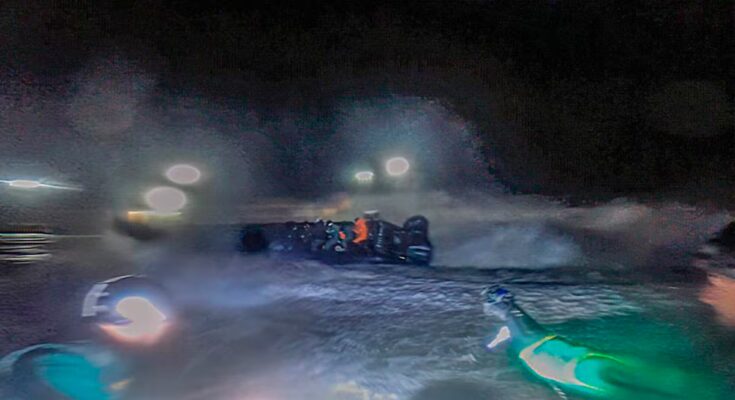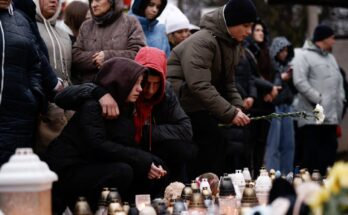The report commissioned 10 months ago to determine whether Karim El Baqqali, the pilot of the drug ship that killed agents Miguel Ángel González and David Pérez in the port of Barbate (Cádiz) on 9 February last year, intentionally rammed the agents’ zodiac or whether it was an accidental event, is already on the table of judge Ángel Rojas, the case’s investigator. The conclusions of the document, to which EL PAÍS had access, do not openly opt for either possibility, but state that El Baqqali did not reduce speed or attempt to vary the trajectory to avoid the crash, although it also underlines that his ability to maneuver could have been reduced by adverse weather conditions. “The collision is explained by the concomitance of human factors (decision to maintain high speed) and environmental factors (darkness, waves, limitation of visual slip),” concludes the October 7 report.
The assessment was entrusted by the judge to a “maritime navigation expert” in order to ascertain “the possibility/probability that the fast vessel (EAV) (formal name given to drug traffickers) had attempted to avoid or avoid the collision with the Guardia Civil patrol boat which was hit”. The instructor also wanted to analyze “the performance” of the pilot “in the moments before, during and after the collision”. The aim was to establish whether to maintain against El Baqqali and the other three occupants of the drug boat, all prisoners, the charge of two crimes of murder and four of attempted murder – by the other civil guards injured in the facts – or whether to reduce them to murder, with the difference in sentences that this would imply in an inevitable sentence after the confession of the four.
In his report, the expert underlines that “in the minutes preceding the impact”, the pilot of the anti-drug boat carried out “circular approach maneuvers and harassment around the Guardia Civil boat” at high speed, despite the sea conditions (the storm had actually led this and five other similar boats to take refuge in the port of Barbate that day) and the visibility (it was night) recommended reducing it. “These trajectories describe large turns around the official vessel, maintaining high speed and without evidence of throttle reduction,” the paper states. Some maneuvers of “approach, departure and new approaches in sequence” which, he adds, “increased the operational tension and reduced the reaction margin of the official crew”, in reference to the six civil guards who were on a smaller boat than that of the drug traffickers. The document highlights that this type of trajectory “increases the difficulty of maneuvering in case of risk of collision, since the gliding speed prevents sudden changes of course in short spaces”.
The report indicates that in the moments before the impact, the anti-drug vessel “abandons the circular turn and heads in a direct direction” towards the zodiac of the armed institute where the agents are traveling without any “significant reduction in speed or lifting of the bow which would indicate a deceleration. The angle of approach coincides with the frontal projection of the semi-rigid (patrol boat) of the agents, which increases the risk of collision”, it underlines. “At an already critical distance (…), the ship maintains a planing regime, which makes any effective evasive maneuver impossible,” the report reads further. The expert adds in this sense that, after the crash, the drug boat “continued to move with inertia and power, confirming that it had not previously reduced its speed”.
The report concludes with seven conclusions in which, in addition to underlining that the anti-drug vessel was traveling at a high speed which “reduced the ability to control and increased the stopping distance”, it is highlighted that “the environmental and meteorological conditions (night darkness, adverse sea and wind) aggravated the limitation of visibility and maneuvering” which limited “the pilot’s ability to perceive and maneuver”. In this sense, he adds that El Baqqali’s field of vision “was limited by the elevation of the bow on planing and the lack of brightness, making early detection of the Civil Guard vessel difficult.”
The expert concludes by stating that the detainee did not comply with at least four rules of the International Regulations for the Prevention of Collisions (RIPA) during the tragic event by not maintaining “effective surveillance in conditions of reduced visibility”, maintaining “excessive speed”, “ignoring an obvious risk of collision” and “not carrying out timely and effective evasive manoeuvres”. For all these reasons, it is concluded that the pilot “departed from recognized international good maritime practices, constituting a determining factor in the production of the collision”.
In its reports, the Guardia Civil concluded that the occupants of the boat that hit the Zodiac of the armed institute that night had a premeditated attitude to kill the officers and, therefore, it was a homicide. “All members of the anti-drug vessel acted with the clear and unequivocal intention of ending the lives of the civil guards who were part of the crew of the official vessel, with evident disregard for their lives,” it emphasized in one of these documents incorporated months ago in the case. And he stressed that they made “several violent approaches” to the patrol boat before moving away “to a sufficient distance that allowed them to reach a high speed, returning again in the direction of the official vessel and finally, without deviating the trajectory to avoid collision, attacking it by entering with the bow from the port side to the starboard side of the stricken vessel”. In September last year, the judge confirmed these findings in the order ordering El Baqqali’s imprisonment.
These deductions contrast with the judicial declaration of the confessed pilot of the drug boat, who turned himself in to the Guardia Civil after remaining in hiding for more than seven months in Morocco. The main defendant tried to justify his actions that night when he felt unwell because he had not slept enough the night before. He also underlined that at first he thought he had only slightly hit the victims’ boat and then learned from news reports on the Internet that there had been two deaths.
Mohamed Laachiri and Yassine El Morabet, two other occupants of the drug boat, only partially supported El Baqqali’s statement when they were arrested two months later, in November last year. Both assured that the latter was responsible as the pilot. However, there were discrepancies in their testimonies. Morabet assured that as they left the port he noticed that the drug ship had collided with something and described the impact as strong, but that he did not know what it had hit. In contrast, Laachiri, who also admitted that he had noticed that the boat they were on had hit something, described the impact as small, so he thought it had hit a buoy. Several reports prepared by the Guardia Civil concluded, however, that the collision had been brutal and could hardly have gone unnoticed by the crew of the drug vessel.



